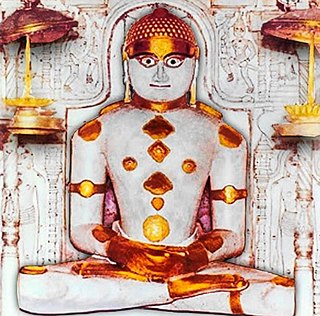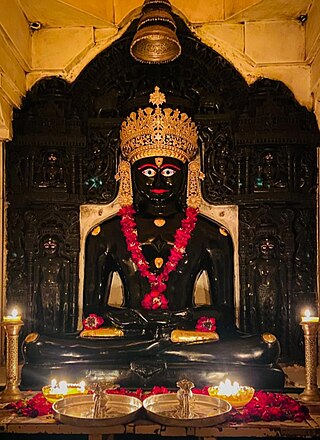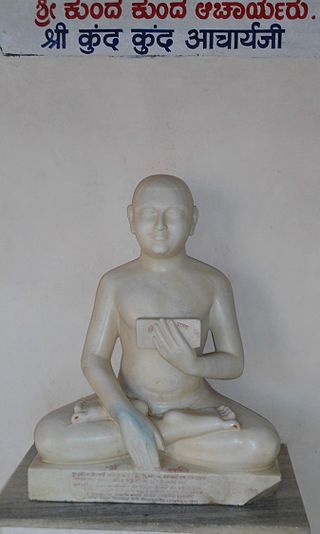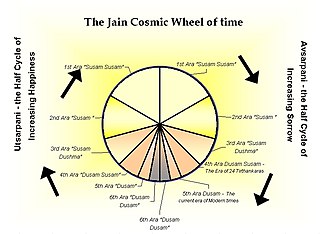
Balarama is a Hindu god. The elder brother of Vāsudeva-Krishna he is described in the Bhagavata Purana as the highest form of divinity that expanded into Vishnu and creation. He is particularly significant in the Jagannath tradition, as one of the triad deities. He is also known as Haladhara, Halayudha, Baladeva, Balabhadra, and Sankarshana.

Mahavira, also known as Vardhamana, was the 24th Tirthankara of Jainism. He was the spiritual successor of the 23rd Tirthankara Parshvanatha. Mahavira was born in the early 6th century BCE into a royal Jain family of ancient India. His mother's name was Trishala and his father's name was Siddhartha. They were lay devotees of Parshvanatha. Mahavira abandoned all worldly possessions at the age of about 30 and left home in pursuit of spiritual awakening, becoming an ascetic. Mahavira practiced intense meditation and severe austerities for twelve and a half years, after which he attained Kevala Jnana (omniscience). He preached for 30 years and attained moksha (liberation) in the 6th century BCE, although the year varies by sect.

The Śvetāmbara is one of the two main branches of Jainism, the other being the Digambara. Śvetāmbara in Sanskrit means "white-clad", and refers to its ascetics' practice of wearing white clothes, which sets it apart from the Digambara or "sky-clad" Jains whose ascetic practitioners go nude. Śvetāmbaras do not believe that ascetics must practice nudity.

In Jainism, a Tirthankara is a saviour and supreme spiritual teacher of the dharma. The word tirthankara signifies the founder of a tirtha, a fordable passage across saṃsāra, the sea of interminable birth and death. According to Jains, tirthankaras are the supreme preachers of dharma, who have conquered saṃsāra on their own and made a path for others to follow. After understanding the true nature of the self or soul, the Tīrthaṅkara attains kevala jnana (omniscience). A Tirthankara provides a bridge for others to follow them from saṃsāra to moksha (liberation).

In Jainism, Balabhadra or Baladeva are among the sixty-three illustrious beings called śalākāpuruṣas that are said to grace every half cycle of time. According to Jain cosmology, śalākāpuruṣa are born on this earth in every Dukhama-sukhamāara. They comprise twenty-four tīrthaṅkaras, twelve chakravartins, nine balabhadra, nine narayana, and nine pratinarayana. Their life stories are said to be most inspiring. According to the Jain puranas, the Balabhadras lead an ideal Jain life.

Parshvanatha, or Pārśva and Pārasanātha, was the 23rd of 24 Tirthankaras of Jainism. He gained the title of Kalīkālkalpataru.

A chakravarti is an ideal universal ruler, in the history, religion, and mythologies of India. The concept is present in Indian subcontinent cultural traditions, narrative myths and lore. There are three types of chakravarti: chakravala chakravarti, an emperor who rules over all four of the continents ; dvipa chakravarti, a ruler who governs only one of those continents; and pradesha chakravarti, a monarch who leads the people of only a part of a continent, the equivalent of a local king. Dvipa chakravarti is particularly one who rules the entire Indian subcontinent (as in the case of the Mauryan Empire. The first references to a Chakravala Chakravartin appear in monuments from the time of the early Maurya Empire, in the 4th to 3rd century BCE, in reference to Chandragupta Maurya and his grandson Ashoka.

Rishabhanatha, also Rishabhadeva, Rishabha or Ikshvaku, is the first tirthankara of Jainism. He was the first of twenty-four teachers in the present half-cycle of time in Jain cosmology, and called a "ford maker" because his teachings helped one cross the sea of interminable rebirths and deaths. The legends depict him as having lived millions of years ago. He was the spiritual successor of Sampratti Bhagwan, the last Tirthankar of previous time cycle. He is also known as Ādinātha, as well as Adishvara, Yugadideva, Prathamarajeshwara and Nabheya. He is also known as Ikshvaku, establisher of Ikshvaku dynasty. Along with Mahavira, Parshvanath, Neminath, and Shantinath, Rishabhanatha is one of the five Tirthankaras that attract the most devotional worship among the Jains.
Jain cosmology is the description of the shape and functioning of the Universe (loka) and its constituents according to Jainism. Jain cosmology considers the universe as an uncreated entity that has existed since infinity with neither beginning nor end. Jain texts describe the shape of the universe as similar to a man standing with legs apart and arms resting on his waist. This Universe, according to Jainism, is broad at the top, narrow at the middle and once again becomes broad at the bottom.

Neminātha, also known as Nemi and Ariṣṭanemi, is the twenty-second Tīrthaṅkara of Jainism in the present age. Neminatha lived 81,000 years before the 23rd Tirthankara Parshvanatha. According to traditional accounts, he was born to King Samudravijaya and Queen Shivadevi of the Yadu dynasty in the north Indian city of Sauripura. His birth date was the fifth day of Shravana Shukla of the Jain calendar. Krishna, who was the 9th and last Jain Vasudev, was his first cousin.
The Ikshvaku dynasty, also known as the Solar dynasty or Sūryavaṃśa was a feudatory tribe that ruled the Andhra region, Krishna River Delta, and Godavari river on the east coast, situating their capital at Dharanikota . they prayed to Surya as their primary deity and considered him as their progenitor. Along with the Lunar dynasty, the Solar dynasty comprises one of the main lineages of the Kshatriya varna in Hinduism.
Harivaṃśapurāṇa was composed by Acharya Jinasena in 783 AD. It is divided into 66 cantos and contains 12,000 slokas. The book aims to narrate the life of Neminatha, the twenty-second Tirthankara in Jainism. According to the Jain sources, Krishna is the first cousin of Tirthankara Neminatha. Therefore, Krishna's adventures too occupy a significant portion of the book. Harivamsa Purana suggests that Draupadi was married to only Arjuna as opposed to Hindu traditional accounts which suggests that she was married to all five Pandavas.

Sanskrit moksha or Prakrit mokkha refers to the liberation or salvation of a soul from saṃsāra, the cycle of birth and death. It is a blissful state of existence of a soul, attained after the destruction of all karmic bonds. A liberated soul is said to have attained its true and pristine nature of infinite bliss, infinite knowledge and infinite perception. Such a soul is called siddha and is revered in Jainism.

Digambara is one of the two major schools of Jainism, the other being Śvetāmbara (white-clad). The Sanskrit word Digambara means "sky-clad", referring to their traditional monastic practice of neither possessing nor wearing any clothes.

Simandhar or Simandhara is a Tīrthaṅkara, an arihant, who is said to be currently living in another world in the Jain cosmological universe.

Auspicious dreams are often described in texts of Jainism which forecast the virtue of children. Their number varies according to different traditions and they described frequently as fourteen or sixteen dreams. They are seen by mothers of the prominent figures in Jainism including Tirthankaras, on the conception of their soul in the womb. They are interpreted as describing virtues and kingship of a future child. They are also found in various artistic media as an ornamentation.

Ajitanatha was the second tirthankara of the present age, avasarpini according to Jainism. He was born to king Jitashatru and Queen Vijaya at Ayodhya in the Ikshvaku dynasty. He was a liberated soul which has destroyed all of its karma.
Jainism and Hinduism are two ancient Indian religions. There are some similarities and differences between the two religions. Temples, gods, rituals, fasts and other religious components of Jainism are different from those of Hinduism.

In Jainism, Bharata was the first chakravartin of the Avasarpini. He was the eldest son of Rishabhanatha, the first tirthankara. He had two sons from his chief-empress Subhadra, named Arkakirti and Marichi. He is said to have conquered all six parts of the world and to have engaged in a fight with Bahubali, his brother, to conquer the last remaining city of the world.

Avasarpiṇī is the descending half of the cosmic time cycle in Jainism and the one in which the world is said to be at present. According to Jain texts the Avasarpiṇī is marked by a decline in goodness and religion. The ascending half of the cycle is called utsarpiṇī, which is marked by the ascent of goodness and religion.





















